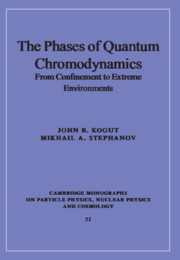Book contents
- Frontmatter
- Contents
- 1 Introduction
- 2 Background in spin systems and critical phenomena
- 3 Gauge fields on a four-dimensional euclidean lattice
- 4 Fermions and nonperturbative dynamics in QCD
- 5 Lattice fermions and chiral symmetry
- 6 The Hamiltonian version of lattice-gauge theory
- 7 Phase transitions in lattice-gauge theory at high temperatures
- 8 Physics of QCD at high temperatures and chemical potentials
- 9 Large chemical potentials and color superconductivity
- 10 Effective Lagrangians and models of QCD at nonzero chemical potential
- 11 Lattice-gauge theory at nonzero chemical potential
- 12 Epilogue
- References
- Index
3 - Gauge fields on a four-dimensional euclidean lattice
Published online by Cambridge University Press: 17 August 2009
- Frontmatter
- Contents
- 1 Introduction
- 2 Background in spin systems and critical phenomena
- 3 Gauge fields on a four-dimensional euclidean lattice
- 4 Fermions and nonperturbative dynamics in QCD
- 5 Lattice fermions and chiral symmetry
- 6 The Hamiltonian version of lattice-gauge theory
- 7 Phase transitions in lattice-gauge theory at high temperatures
- 8 Physics of QCD at high temperatures and chemical potentials
- 9 Large chemical potentials and color superconductivity
- 10 Effective Lagrangians and models of QCD at nonzero chemical potential
- 11 Lattice-gauge theory at nonzero chemical potential
- 12 Epilogue
- References
- Index
Summary
Lattice formulation, local gauge invariance, and the continuum action
In its standard formulation, lattice-gauge theory replaces the continuum spacetime of Euclidean quantum-field theory with a four-dimensional lattice of spacetime points and links. If the lattice is hypercubic, then its lattice spacing a provides an ultraviolet cutoff. Although such a spacetime cutoff is not convenient in most analytic calculations, it has several extraordinary advantages. First, it allows strong-coupling calculations both through expansions and by simulation methods. These approaches provide a framework for formulating and developing physical pictures of confinement, chiral-symmetry breaking, and other nonperturbative phenomena that are so challenging in ordinary continuum formulations of quantum-field Theory.
The various fields of the lattice version of quantum chromodynamics exist on the sites and links of the regular lattice. In the standard formulation, the fermion fields reside on the sites and the gauge fields reside on the links [10]. The fermion fields, matter fields in general, carry the color quantum number of the gauge group SU(3). It is convenient, therefore, to imagine that there is a color frame of reference at each site so that the fermion field with color index α, ψα, can be visualized. (This geometrical point of view dates back to the original Yang–Mills paper which introduced non-Abelian gauge fields into high-energy physics when they generalized the notion of isospin symmetry from the familiar global symmetry of nuclear physics to a local symmetry of high-energy field theory [11].)
- Type
- Chapter
- Information
- The Phases of Quantum ChromodynamicsFrom Confinement to Extreme Environments, pp. 53 - 73Publisher: Cambridge University PressPrint publication year: 2003



